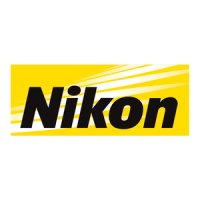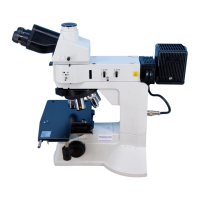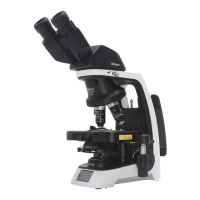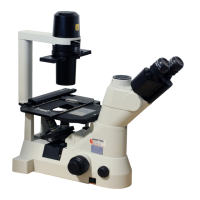5
CAUTION
7. Cable routing
Make sure the cables are routed properly. Do not bring the cables into contact with the lamp
house for the diascopic illumination. If a cable comes into contact with the lamp house, the
cable sheath may melt and it results in an electrical shock or fire.
8. Cautions when replacing lamps
• To prevent burn injuries, wait at least 30 minutes after the lamp is turned off to give it
sufficient time to cool down when replacing lamps.
• To prevent electrical shock and damage to the microscope, always turn off the power
switch (flip it to the “ ” side) and unplug the power cord from the outlet before attaching
or detaching the lamp house.
• Never touch the glass surface of the lamp with bare hands. Doing so will cause
fingerprints, grease, etc. to burn onto the lamp surface, reducing the illumination. If you
do get any fingerprints or dirt on the lamp, wipe them clean.
• Make sure the lamp house cover is securely fitted to the lamp house after replacing lamps.
Never turn on the lamp with the lamp house cover removed.
• When you dispose of the replaced lamp, do not break it up. Instead, dispose of the used
lamp as special industrial waste or dispose of it according to the local regulations and
rules.
9. Notes on handling a filter cube
When using the product configured with the illuminator LV-UEPI2A, a filter cube can be
attached to enable epi-fl microscopy. Note the following precautions for handling a filter
cube.
• Interference filters (especially excitation light filters, which are exposed to strong light)
deteriorate over time. Replace them depending on their total operating hours.
• Filter characteristics may alter if the filter is exposed to high humidity. To prevent
changes or degradation of filter characteristics, avoid using or storing the filters under
conditions of high humidity or high temperature and avoid subjecting the filters to rapid
temperature changes. When a filter is not in use, store it in a desiccator or hermetically
sealed container with a drying agent.
• The filters attached in the nine types of filter cubes listed below have sharper wavelength
characteristics than standard filters. However, due to their sophisticated coatings, they
must be handled with special care. In particular, take care to avoid abrasion from cleaning.
Observe the procedures described in “1. Cleaning Lenses and Filters” of “VI. Care and
Maintenance.”
Single band filter cubes: DAPI, FITC, TxRed, GFP
Multi band filter cubes: F-R, F-T, D-F, D-F-R, D-F-T
10. Software setup works after assembly
When the microscope is assembled or the configuration of the microscope is changed,
perform the software setup works for various settings of the microscope via a PC by using
the software, “LVSetup,” in “LV Series Support Tools” provided with this product.
In the setup works, information for the parts and devices (objectives, filter cubes,
illuminator, and so on) is registered into the memory in the microscope and interlock
controls for such devices are specified. Make sure to perform the setup works to use the
microscope correctly.
For details about the operation and the setup works of the “LVSetup,” refer to the “LV
Series Support Tools software manual.”

